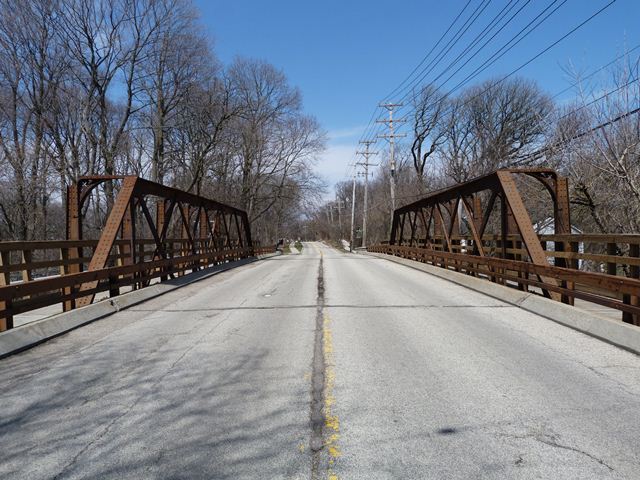We Recommend:
Bach Steel - Experts at historic truss bridge restoration.
BridgeHunter.com Phase 1 is released to the public! - Visit Now
Green Bay Road Bridge
Green Bay Road Trusses

Primary Photographer(s): Nathan Holth
Bridge Documented: April 14, 2013
Lake Bluff: Lake County, Illinois: United States
By Builder/Contractor: Unknown
1988
70.0 Feet (21.3 Meters)
170.0 Feet (51.8 Meters)
26 Feet (7.92 Meters)
3 Main Span(s)
49680215346

View Information About HSR Ratings
Bridge Documentation
Additional Information: John Marvig suggests that this bridge could have originally been built as a railroad bridge in the 1880s. The Chicago NorthWestern Railroad liked to reuse bridges and bridge parts. Bridges from this era were often converted for highway overpass use between 1895 and 1915 when the railroad mainline was reconstructed. The overhead bracing on the sidewalks are likely salvaged material from other bridges reused on this bridge, and not original to the bridge's initial railroad construction.
View Archived National Bridge Inventory Report - Has Additional Details and Evaluation
This bridge was sadly demolished and replaced in 1988, however the only good news is that the extremely unusual and highly significant truss webs of the bridge were placed on the replacement bridge as decorations. These trusses have several unusual details. The double-Warren truss configuration is unusual, especially in the Chicagoland area. However the most unusual feature is what looks like "archways" over the cantilevered sidewalks. Although these elements include decorative knee braces with punch-out decorations, these "archways" are not decorative features. They are actually the outriggers for the pony truss, designed to provide lateral stability. The use of outriggers was a common way to stabilize pony trusses that did not get enough lateral stability from the trusses themselves. However, if it was desired to design a pony truss with outriggers, but also with cantilevered sidewalks, a practical problem developed. The outriggers would stick out into the sidewalk, or the sidewalk would have to be extended out beyond the outriggers which would be an inefficient design. As such, the designers of this bridge simply placed the outriggers outside of the cantilevered sidewalk, and connected them to the top of the truss via overhead beams. This produced the "archways" seen on the bridge.
Based on style, the bridge could be as old as the 1890s. If so, it is also significant as an early surviving example of a rivet-connected truss bridge.
The bridge trusses make efficient use of materials at the expense for a more complicated design. Diagonal members become increasingly lightweight toward the center of the truss, representing the distribution of loads within the truss web.
Note: The bridge dimensions given are for the replacement bridge. The length, width and span number of the historic bridge would have been different. The bridge is likely wider than the original, and where the current bridge is three spans, the original bridge may have been single span (just the truss) or there may have been flanking approach spans of some sort.
![]()
Photo Galleries and Videos: Green Bay Road Bridge
Bridge Photo-Documentation
Original / Full Size PhotosA collection of overview and detail photos. This gallery offers photos in the highest available resolution and file size in a touch-friendly popup viewer.
Alternatively, Browse Without Using Viewer
![]()
Bridge Photo-Documentation
Mobile Optimized PhotosA collection of overview and detail photos. This gallery features data-friendly, fast-loading photos in a touch-friendly popup viewer.
Alternatively, Browse Without Using Viewer
![]()
Maps and Links: Green Bay Road Bridge
Coordinates (Latitude, Longitude):
Search For Additional Bridge Listings:
Bridgehunter.com: View listed bridges within 0.5 miles (0.8 kilometers) of this bridge.
Bridgehunter.com: View listed bridges within 10 miles (16 kilometers) of this bridge.
Additional Maps:
Google Streetview (If Available)
GeoHack (Additional Links and Coordinates)
Apple Maps (Via DuckDuckGo Search)
Apple Maps (Apple devices only)
Android: Open Location In Your Map or GPS App
Flickr Gallery (Find Nearby Photos)
Wikimedia Commons (Find Nearby Photos)
Directions Via Sygic For Android
Directions Via Sygic For iOS and Android Dolphin Browser
USGS National Map (United States Only)
Historical USGS Topo Maps (United States Only)
Historic Aerials (United States Only)
CalTopo Maps (United States Only)

